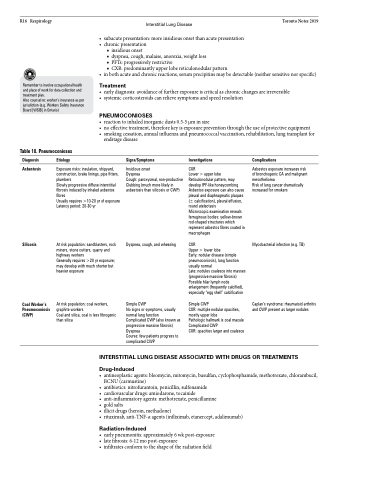Page 1262 - TNFlipTest
P. 1262
R16 Respirology
Interstitial Lung Disease
Toronto Notes 2019
Remember to involve occupational health and place of work for data collection and treatment plan.
Also counsel re: worker’s insurance as per jurisdiction (e.g. Workers Safety Insurance Board [WSIB] in Ontario)
Table 18. Pneumoconioses
• subacutepresentation:moreinsidiousonsetthanacutepresentation • chronicpresentation
■ insidious onset
■ dyspnea, cough, malaise, anorexia, weight loss
■ PFTs: progressively restrictive
■ CXR: predominantly upper lobe reticulonodular pattern
• inbothacuteandchronicreactions,serumprecipitinsmaybedetectable(neithersensitivenorspecific)
Treatment
• earlydiagnosis:avoidanceoffurtherexposureiscriticalaschronicchangesareirreversible • systemiccorticosteroidscanrelievesymptomsandspeedresolution
PNEUMOCONIOSES
• reactiontoinhaledinorganicdusts0.5-5μminsize
• noeffectivetreatment,thereforekeyisexposurepreventionthroughtheuseofprotectiveequipment
• smokingcessation,annualinfluenzaandpneumococcalvaccination,rehabilitation,lungtransplantfor
endstage disease
Diagnosis
Asbestosis
Etiology
Exposure risks: insulation, shipyard, construction, brake linings, pipe fitters, plumbers
Slowly progressive diffuse interstitial fibrosis induced by inhaled asbestos fibres
Usually requires >10-20 yr of exposure Latency period: 20-30 yr
At risk population: sandblasters, rock miners, stone cutters, quarry and highway workers
Generally requires >20 yr exposure; may develop with much shorter but heavier exposure
At risk population: coal workers, graphite workers
Coal and silica, coal is less fibrogenic than silica
Signs/Symptoms
Insidious onset
Dyspnea
Cough: paroxysmal, non-productive Clubbing (much more likely in asbestosis than silicosis or CWP)
Dyspnea, cough, and wheezing
Simple CWP
No signs or symptoms, usually normal lung function
Complicated CWP (also known as progressive massive fibrosis) Dyspnea
Course: few patients progress to complicated CWP
Investigations
CXR
Lower > upper lobe Reticulonodular pattern, may develop IPF-like honeycombing Asbestos exposure can also cause pleural and diaphragmatic plaques (± calcification), pleural effusion, round atelectasis
Microscopic examination reveals ferruginous bodies: yellow-brown rod-shaped structures which represent asbestos fibres coated in macrophages
CXR
Upper > lower lobe
Early: nodular disease (simple pneumoconiosis), lung function usually normal
Late: nodules coalesce into masses (progressive massive fibrosis) Possible hilar lymph node enlargement (frequently calcified), especially “egg shell” calcification
Simple CWP
CXR: multiple nodular opacities, mostly upper lobe
Pathologic hallmark is coal macule Complicated CWP
CXR: opacities larger and coalesce
Complications
Asbestos exposure increases risk of bronchogenic CA and malignant mesothelioma
Risk of lung cancer dramatically increased for smokers
Mycobacterial infection (e.g. TB)
Caplan’s syndrome: rheumatoid arthritis and CWP present as larger nodules
Silicosis
Coal Worker’s Pneumoconiosis (CWP)
INTERSTITIAL LUNG DISEASE ASSOCIATED WITH DRUGS OR TREATMENTS
Drug-Induced
• antineoplasticagents:bleomycin,mitomycin,busulfan,cyclophosphamide,methotrexate,chlorambucil, BCNU (carmustine)
• antibiotics: nitrofurantoin, penicillin, sulfonamide
• cardiovasculardrugs:amiodarone,tocainide
• anti-inflammatoryagents:methotrexate,penicillamine
• goldsalts
• illicitdrugs(heroin,methadone)
• rituximab,anti-TNF-αagents(infliximab,etanercept,adalimumab)
Radiation-Induced
• earlypneumonitis:approximately6wkpost-exposure • latefibrosis:6-12mopost-exposure
• infiltratesconformtotheshapeoftheradiationfield


